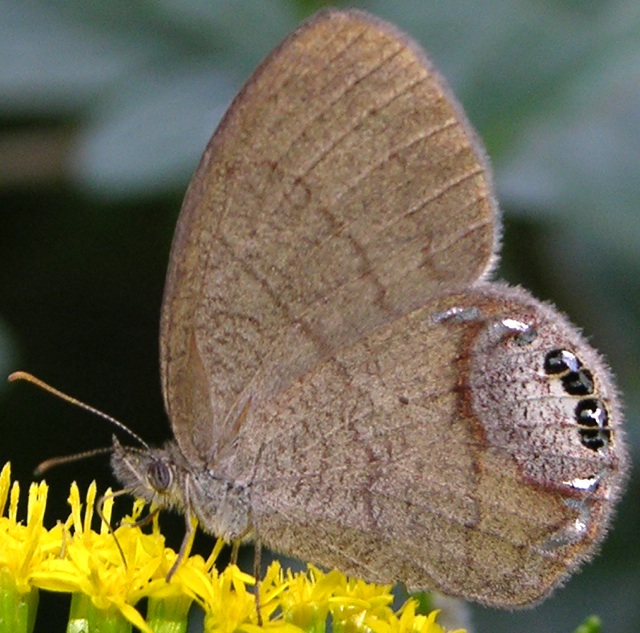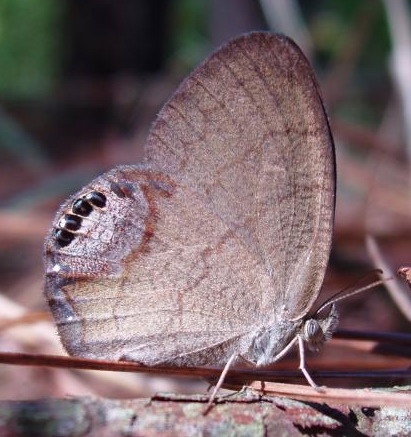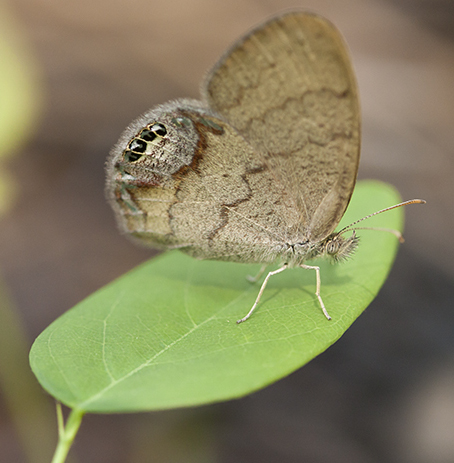|
| Common Name | Gemmed Satyr by Roger Rittmaster
[View PDF]
 Click to enlarge Click to enlarge
[Google Images] GBIF [Global Distribution ] BoA [Images ] iNaturalist |
| Scientific Name | Cyllopsis gemma
|
| Link to BAMONA species account. |
| Map | Click on a county for list of all database records for the species in that county.
 |
| Distribution | DISTRIBUTION: Essentially statewide, but quite spotty in the Coastal Plain, especially in the northeastern corner of the state. Scattered in the lower elevations of the Mountains; few records for the northern Mountains, though recorded in all of these counties except one (Avery).
|
| Abundance | ABUNDANCE: Uncommon to fairly common in the Piedmont; very uncommon to rare, and spottily distributed, in the Coastal Plain, and possibly absent in some counties. Uncommon in the southern Mountains, generally at low elevations; rare in the northern Mountains and at higher elevations.
|
| Flight | FLIGHT PERIOD: Three broods. Late March to late May, early June to mid-July, and late July to late October. The middle brood is conspicuously small.
|
| Habitat | HABITAT: Generally found in the partial shade of open hardwood forests. It favors upland woods, ranging from foothill ridgetops to somewhat moist woods. However, it is infrequent in bottomlands or other wet woods. It tends to be seen where there are grasses in the forest, such as near or along trails, or along the margins of roads through forests. It also occurs in Coastal Plain pinewoods, such as flatwoods, to an extent, but I have found it mainly in association with grasses in hardwoods. Note that most field guides and references have the habitat for this species described incorrectly, or confused with Carolina Satyr; they tend to say that the Gemmed occurs mainly in moist forested habitats and the Carolina in moist or upland habitats! These authors, unfortunately, do not live within the range of these satyrs, or at least within the range of the Gemmed Satyr. As a reminder, the Gemmed Satyr occurs in drier habitats than does the Carolina Satyr, though they can often be found together.
|
|
| | Plants | FOOD AND NECTAR PLANTS: Various grasses are the foodplants, typically native grasses growing in woodlands as opposed to fields and edges; it apparently does not feed on Japanese Stilt-grass (Microstegium vimineum). As with other satyrs, it seldom nectars; feeds on sap, dung, moisture, etc.
|
| Comments | COMMENTS: The satyrs in NC have a distinctive bouncing, up and down, flight that separates them from other butterflies. The Gemmed is often found in the same habitats as the Carolina Satyr, but it tends to be less numerous in wetland forests than the Carolina Satyr. The Gemmed is slightly lighter or warmer brown and is very slightly larger. However, the observer must always follow them and wait for them to perch on the ground or on leaves to clinch the identification. If it spreads the wings open when perched, it is not a Gemmed (as it never spreads its wings open).
The Butterflies of America website uses "Gemmed-Satyr" in the name for nearly all of the Cyllopsis satyr species, such as Canyonland Gemmed-Satyr and Eastern Gemmed-Satyr, but oddly still retaining "Nabokov's Satyr"! However, our NC website will refrain from using Eastern Gemmed-Satyr for now, as essentially all reference books and the NatureServe Explorer avoid the use of "Gemmed-Satyr", and continue to call this species as the Gemmed Satyr.
|
State Rank | S5 | | State Status | |
Global Rank | G4G5 [G5] | | Federal Status | |
| Synonym |
|
| Other Name | Eastern Gemmed-Satyr
|
|
|

 >>
>>

